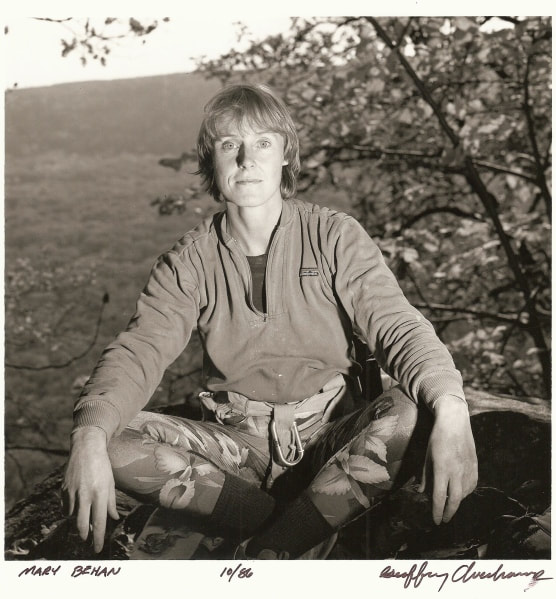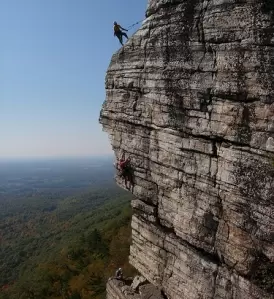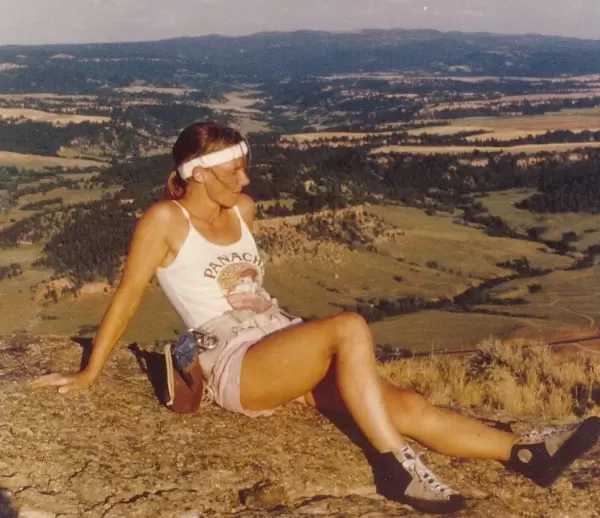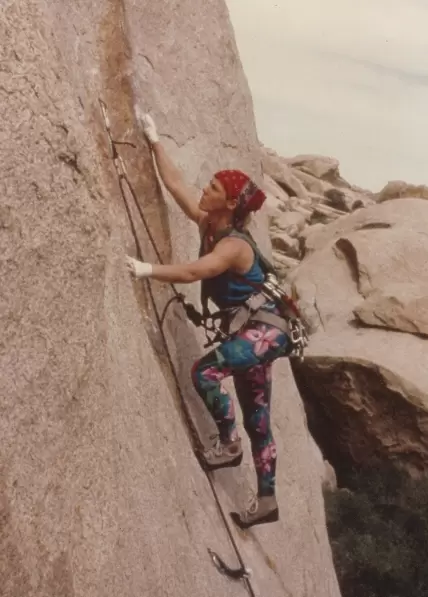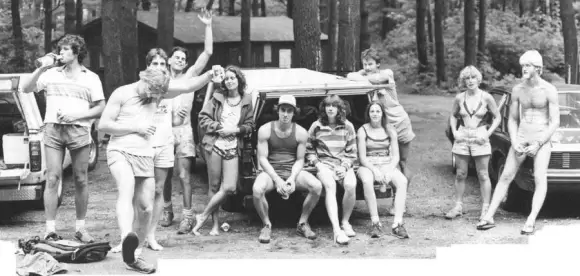|
SWAMI BELTS AND SWINGIN’ LEADS: FULL INTERVIEW WITH CLIMBER MARY BEHAN As you immerse yourself into the climbing culture, you hear the stories of the local climbing legend. For me, learning to climb in Wisconsin, there was Mary Behan. Imagine an Irish Lynn Hill, combined with Amelia Earhart, mixed with Marie Curie…and you have a rough idea of Mary’s legendary status. Many a day climbing ended on Mary’s cabin porch, listening to her recount her climbing adventures. Lucky for you, she’s shared her stories (and pictures) of climbing in the ’70s and ’80s with CruxCrush. (For the full interview and images, check out https://cruxcrush.wordpress.com/swami-belts-and-swingin-leads-full-interview-with-climber-mary-behan/) CC: How did you first get into climbing? MB: “In the Summer of 1978, I fell in love with a guy who had two passions: science and climbing. It was clear to me that if I was going to see him at weekends (we worked in the same building), I would have to to learn how to climb. Fortunately he was a good teacher and I took to it easily. We spent every weekend during the Wisconsin “season” at the local crag, Devil’s Lake State Park, about an hour’s drive from Madison. He had a rope, some gear and lots of webbing. I’d tie into the rope directly, or make a swami belt of webbing looped around my waist about 6 times. Even with leg loops, it didn’t encourage hanging! Maybe that’s why I developed a strong reluctance to fall. The bluffs at Devils Lake are short (~75 ft.), with routes packed close together. The rock is quartzite, slick and hard, so most people invested in climbing shoes, EBs in those days. Sticky rubber hadn’t yet arrived. Pretty much everyone top-roped. Occasionally someone would lead or aid a route, and you knew that they were getting ready to go on a climbing trip to Colorado or Yosemite. My boyfriend had spent a couple of months climbing in Yosemite a year or two earlier, and used to reminisce about Camp 4 and the life of a climbing bum. He brought me there in 1980 and again in 1981. By this time I had bought a harness, painter pants and a rugby jersey, which constituted the cool climbing outfit of the day. We were in Yosemite for the earthquake in May, 1980 (6.2 Magnitude). It pretty much cleared out the park of tourists, so climbers had it all to themselves. But nobody wanted to get caught by an aftershock on a big wall as there were stories of gear being crushed in cracks, becoming permanent protection. We climbed lots of short routes. He always led, so I learned to clean. I never thought about leading, and he never encouraged me. CC: How would you describe the climbing culture in which you learned to climb? MB: There weren’t many females climbing, and those who did were always half of a couple. The guys always selected routes to climb, and set up the anchors. But the great thing was that at Devils Lake anyone would let you climb on their rope in exchange for a belay, so, very quickly I got to know a lot of people and notched up lots of top rope successes. In addition to the locals from Madison, there were also regulars from Chicago, Milwaukee, Minneapolis, Minnesota and and Iowa. The atmosphere was great, and guys were very encouraging, – maybe because women were a novelty and unlikely to outshine them! At the end of a day we would hang out in the parking lot by the CCC (Civilian Conservation Corps) camp drinking beer, re-living the triumphs and failures of the day, and planning future assaults. Most of the out-of-towners camped at the park, and parties lasted long into the night. I was renting a cabin on a lake in Madison at the time, and it quickly became a place for some of the climbers to crash. CC: What was it like to be a female climber in the 70’s and 80’s? MB: It was brilliant! But let me go back a little. After I had been climbing for a couple of years, my boyfriend dumped me rather abruptly for another woman. I remember driving up to Devils Lake one Saturday shortly afterwards, seeing his car in the car park, and driving home – I just couldn’t face the new girl friend. The following Saturday I went to Devils Lake again and sure enough, his car was there. But this time a couple of guys whom I had got to know noticed my hesitation and said: It’s OK Mary, you can climb with us. Those guys changed my life, and looking back, I doubt I would have stuck with climbing without their friendship and encouragement. They opened up an amazing independent climbing life to me, and they remain close friends. CC: Who or what inspired you as a climber? MB: There were very few female role models. My first boyfriend used to talk about a woman called Molly Higgins who climbed in Yosemite. I never met her, but she sounded great. Apparently she could lead off-width cracks effortlessly. I tried one of her routes there and was totally flummoxed by it. But I presumed that she was bigger, taller, stronger. Then along came Lynn Hill, and suddenly I no longer had any excuses – she was the same height and weight as me, and she was an outstanding climber. She still is. Actually, a few of my male climbing partners inspired me. As far as they were concerned, there was nothing I couldn’t achieve. They were supportive, non-judgemental, non-competitive (because they were much better climbers than me altogether), and just fun to be with. They looked out for me but didn’t crowd me. One of these guys taught me how to lead. He was from North Carolina and I met him when I was there doing research. We went on a climbing trip in the Summer of 1983 that included Devils Tower, Eldorado Canyon, Estes Park, Ophir Wall, Ouray Canyon, and the Black Canyon of the Gunnison. Our first stop was Devil’s Tower and he encouraged me to swing leads the Durrance route (6-pitch, 5.7). Topping out was fabulous – an amazing feeling of accomplishment. Next came Bastille Crack in Eldorado Canyon, another 5-pitch, 5.7 classic, where I insisted on leading all the pitches! By the end of those few weeks, I felt that I had become a “real” climber. CC: What role did climbing play in your life back then? MB: Climbing became everything in my life back then (besides work, of course). By this time (1984) I had bought an 1850’s log cabin on 30 acres half way between Madison and Devils Lake, a location chosen deliberately for its proximity to our local crag. The cabin was pretty basic, and needed a lot of work. But it was (and continues to be) a magical place where everyone was/is welcome at all times. The typical Summer weekend included lots of climbing, with half a dozen climbers coming back to the cabin to stay. We’d do a little work on the cabin followed by great food and drink, and uproarious evenings. Sometimes there were dedicated work parties – weekends of chopping wood, chinking the cabin, building the sauna, digging a garden, or fixing up the barn (which had a chin-up bar, climbing board, Bachar ladder and a “crack machine” – an artificial crack made out of wood, some 20 ft. high. Climbing gyms were not yet in the picture). There were ponds to swim in, the sauna, and eventually a hot tub to take the edge off the pain of throwing ourselves at harder and harder routes. If the weather didn’t favor climbing we’d drive around the area looking for new crags, or go mountain biking, or crosscountry skiing in Winter. It was a wonderful time! Boyfriends came and went in my life over those years, and if the climbers didn’t like them, they let me know in no uncertain terms. I always had people to climb with (male and female). We went on lots of climbing trips: Joshua Tree, Red Rocks, Wild Iris in Wyoming, the Shawangunks in New York, Cochite Mesa in Arizona, the Niagra Escarpment in Canada, New River Gorge, Cannon, Whitehorse and Cathedral in New Hampshire, Looking Glass, Whiteside, Stone Mountain and Moore’s Wall in North Carolina. My favorite climbing area? The Shawangunks – I went there half a dozen times in the 80’s and have wonderful memories of the place. CC: Describe your most memorable climbing experience MB: My first time doing a multi-pitch route with another woman. She and I were good friends and we had climbed lots of times together. But the guys (her husband and my climbing partner) were always with us. They usually selected the climbs, led, and one or other of us would follow and clean the route. On a trip to the Shawangunks in 1984, the guys had an overhanging project they wanted to work on. For some reason, that day neither she nor I were in the humor to sit below and watch and wait and admire their efforts. So we said we’d find something else, and headed off to a different area. We chose something called “High Exposure”, a great 3-pitch classic that challenges body and mind, even though it’s only a 5.6. For the first time ever, we didn’t have the guys to rescue us if anything went wrong. It was exhilarating swinging leads with her, knowing that we were partners with more-or-less equal skills, yet equally terrified. The joy of success was so sweet, and the feeling of independence was magnificent. By the end of that trip, she and I were swinging leads on 5.9s and having a ball. CC: Climbing has changed a lot over the last few decades. What changes have surprised and amazed you the most? The biggest changes are indoor climbing and the abundance of sport routes. They didn’t really exist for us in the late 70’s and early 80’s. When a gym opened “nearby” (a 4-hour drive from Madison!), we made regular pilgrimages to it on wet weekends. Before there was a commercial gym in Madison (Boulders), someone had kitted out a rural barn near Verona, and invitations to train there were highly prized. Now everyone can train year round. Consequently the standards of climbing have increased enormously. Similarly, sport routes (or well-bolted routes) have made outdoor climbing so much more accessible. You don’t have to take as many risks, especially when you are attempting something above your regular abilities. And you don’t have to invest in a rack (although there’s nothing like the sound of someone racking their gear in preparation for a lead!) CC: What advice do you have for a female climber today? MB: Climb for the right reasons – because you enjoy it, because you enjoy the people it brings you in contact with, the places it takes you to, and the experiences and memories it provides. If you’re not having fun…, well, there’s always another day to climb. CC: What role does climbing play in your life today? MB: Somewhere in my late 40’s/early 50’s it was clear to me that I wasn’t getting any better at climbing. And there were other things in my life that took time away from it (including a long-term relationship, and eventual marriage to a non-climber). I’d still get on a rope if the opportunity arose, but I wasn’t actively pursuing climbing, going on climbing trips, working out at the climbing gym, etc. Then in 2006 I ended up with a new graduate student in my lab who was passionate about climbing! His enthusiasm was infectious and the lab became alive with the buzz of gear, routes, beta, trips, etc. It was all wonderfully familiar and I got to “re-live” the climbing life vicariously. This new crowd also climbed at Devils Lake, and would often stop by my cabin on their way home to sit on the porch eating and drinking and telling climbing stories, sometimes together with friends from my earlier climbing days. The new breed of climbers are just as wonderful as the first time round, and some of them have become great friends. That’s why this interview is on CruxCrush! It’s been almost two years since I climbed (I‘m 62). It was the first pitch of a 5.8 route at Cannon Mountain in New Hampshire, a route that I had waltzed up some 30 years earlier. Even with a great partner, this time I decided to back off after the first pitch, knowing that the remaining 4 pitches would not be fun. I didn’t mind though – it was still a wonderful day of climbing! Hardly a day goes by that I don’t come across some reminder of climbing over the past 30 years. Even if I never climb again, it always will be a huge part of my life. CC: What is the most important part of climbing to you? MB: Hands down, the people I have met through climbing. But there are other benefits: the amazingly beautiful places that you get to visit on climbing trips; sitting on a belay ledge a couple of hundred feet up knowing that very few people get to have this experience. And of course, you can go to a climbing gym anywhere in the world and immediately make friends. |
Skill OneSed ut perspiciatis unde omnis iste natus error sit voluptatem accusant doloremque laudantium, totam rem.
|
Skill TwoSed ut perspiciatis unde omnis iste natus error sit voluptatem accusant doloremque laudantium, totam rem.
|
Skill ThreeSed ut perspiciatis unde omnis iste natus error sit voluptatem accusant doloremque laudantium, totam rem.
|
